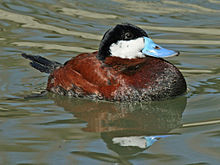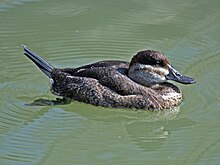Ruddy duck
| Ruddy duck | |
|---|---|
 |
|
| Male | |
 |
|
| Female | |
| Scientific classification | |
| Kingdom: | Animalia |
| Phylum: | Chordata |
| Class: | Aves |
| Order: | Anseriformes |
| Family: | Anatidae |
| Subfamily: | Oxyurinae |
| Genus: | Oxyura |
| Species: | O. jamaicensis |
| Binomial name | |
|
Oxyura jamaicensis (Gmelin, 1789) |
|
| Subspecies | |
 |
|
|
Subspecies ranges
O. j. jamaicensis O. j. ferruginea |
|
| Synonyms | |
|
Erismatura jamaicensis |
|
O. j. jamaicensis O. j. ferruginea
Erismatura jamaicensis
The ruddy duck (Oxyura jamaicensis) is a duck from North America and the Andes Mountains of South America, one of the stiff-tailed ducks. The genus name is derived from Ancient Greek oxus, "sharp", and oura, "tail", and jamaicensis is Jamaica.
These are small, compact ducks with stout, scoop-shaped bills, and long, stiff tails they often hold cocked upward. They have slightly peaked heads and fairly short, thick necks. Male Ruddy Ducks have blackish caps that contrast with bright white cheeks. In summer, they have rich chestnut bodies with bright blue bills. In winter, they are dull gray-brown above and paler below with dull gray bills. Females and first-year males are brownish, somewhat like winter males but with a blurry stripe across the pale cheek patch. In flight, Ruddy Ducks show solidly dark tops of the wings.
The southern subspecies ferruginea is occasionally considered a distinct species. It is separable by its all-black face and larger size. The subspecies andina has a varying amount of black coloration on its white face; it may in fact be nothing more than a hybrid population between the North American and the Andean ruddy duck. As the Colombian population is becoming scarce, it is necessary to clarify its taxonomic status, because it would be relevant for conservation purposes.
Their breeding habitat is marshy lakes and ponds. They nest in dense marsh vegetation near water. The female builds the nest out of grass, locating it in tall vegetation to hide it from predators. A typical brood contains 5 to 15 ducklings. Pairs form each year.
They are migratory and winter in coastal bays and unfrozen lakes and ponds.
These birds dive and swim underwater. They mainly eat seeds and roots of aquatic plants, aquatic insects and crustaceans.
...
Wikipedia

